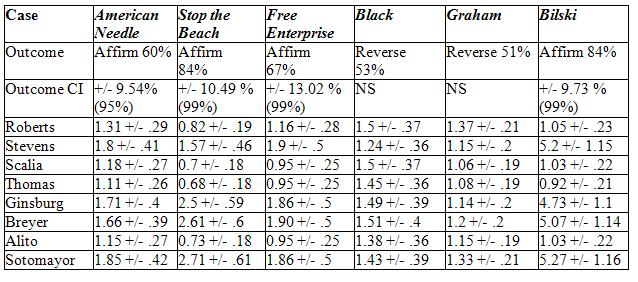The Supreme Court has yet to decide 56 cases for the October 2009 term . In this installment, we will provide predictions for Bilski v. Kappos, American Needle Inc. v. NFL, Free Enterprise Fund and Beckstead and Watts, LLP v. Public Company Accounting Oversight Board, Black v. United States, and Graham v. Florida.
American Needle considers whether the National Football League, its teams, and their licensing agent’s function as a single entity for purposes of the Sherman Act. A majority, 60% of the members of the league are predicting an affirmance of the lower court, at a 95% confidence. The SMRs show a tendency for the liberal justices to join with the conservatives in this decision, with Sotomayor most likely to join in the majority.
Stop the Beach considers the limits on state authority to restore storm-eroded beaches or lakefronts. Eighty-four percent of the members of the league are predicting that the Supreme Court affirms the Florida Supreme Court. In this case, the SMRs show that there is a strong potential for a conservative objection to the majority position, with Thomas possibly being the most vocal objection. This is not a big surprise in light of Justice Thomas’ staunch defense of property rights. The liberal justices are really strong for this case. Though Stevens’ low SMR is due to the fact he has already recused himself from this decision. Though, not everyone has followed this news, and some have cast votes for Stevens.
Predictions for PCAOB, Black, Graham, and Bilski, after the jump at JoshBlackman.com.
Public Company Accounting Oversight Board, or PCAOB (pronounced Peek-A-Boo) considers the constitutionality of the Sarbanes-Oxley Act’s creation of accounting review board. Sixty-seven percent of our members are predicting an affirmance at a 99% confidence level. The data suggest that the liberal justices may join the conservative judges in the majority, and Stevens and Breyer are most likely to join the majority. Thomas and Scalia’s SMRs are not significantly different than one, but their low value might indicate a concurring opinion as opposed to the pure objections of a dissent.
Black v. United States considers the application of “honest services” fraud law to private conduct. In this case, the statistics are inconclusive, and the case is too close to call. The SMRs point to Stevens as the objector, but all Justices in general indicate a tendency to join in the majority. Thomas and Scalia are more likely to join than Alito. The SMRs are not as informative for direction, but they do show that whatever the outcome, it will probably be another large majority, and not be closely divided.
Graham considers the constitutionality of life prison sentence for a juvenile convicted of a non-homicide crime. The statistics in this case are also indeterminate. This one is also too close, as the SMRs indicate that the liberal justices are likely to stay in their ideological camp, except for Sotomayor who may cross over into a conservative majority. However, the SMRs also show that Roberts has a much higher chance of joining the majority than ideology would indicate.
Finally, Bilski, a potentially landmark intellectual property case, considers the definition of modern inventions for purposes of patent eligibility. Our members suggest that this case will likely affirm the Federal Circuit. The SMRs are interesting for this ase, since the liberal justices all have SMRs close to five, indicating an extremely strong potential for joining in any eventual majority. Thomas’s SMR indicates that he has the weakest potential, but is still not significantly different from 1, possibly indicating that he will issue a concurring opinion. This does not seem to be a particularly partisan case.
Many thanks to Corey Carpenter for his assistance with this post.
